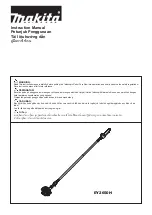
- 13 -
If the blade gets stuck in the workpiece, switch
off the power tool straight away and using a
tool open the cutting groove then free the blade
and extract it.
When cutting metals, continuously cool the
blade by pouring a few drops of cutting oil (not
included), otherwise the blade will wear down
quickly. Caution! Do not use excessive quantities
of liquid and do not pour it onto the electrical tool.
To make pocket cuts, such as an opening (circle,
square, etc.), drill a hole inside the area you
wish to cut out (hole Ø > blade width), grab
the power tool and slip the blade inside the hole
you just made; switch the tool on and proceed
with your cut. For curved cuts, go slowly so you
don’t bend the blade.
For cutting vertical panels, start from the top part
and move downward; in this manner, the wood
chips and sawdust will fall to the floor and not
toward you or the tool.
Ceiling cuts must be done with extreme caution
and care: Wear a safety helmet. Do not do this
type of cut in panels that produce dust (wood,
etc.).
MAINTENANCE
!
!
IMPORTANT! Before any checks or
adjustments unplug the tool from the electric
power supply.
!
!
IMPORTANT! Do not tamper or attempt to
repair the power tool.
!
!
IMPORTANT! Any internal service or
replacement of the motor’s graphite brushes,
which wear with use, must be carried out
exclusively by an authorised service centre.
The working life and costs also depend on con-
stant and meticulous maintenance.
Take good care of your electrical tool and clean it
regularly. In this way its efficiency will be ensured
and its lifespan extended.
- Remove dust and machining residuals with a
cloth or a brush with soft bristles.
- Do not wet or spray water over the power tool
- risk of internal infiltrations.
- Do not use any flammables, detergents or
solvents. The plastic parts can easily be
damaged by chemical agents.
- Remove any traces of resin that will deposit on
the tool.
- Be careful when cleaning the switch, motor fan
slots, handgrips and blade holder.
- Lubricate the blade holder with a little spray oil.
REPLACING THE BLADE
!
!
IMPORTANT! Before any replacements,
switch the tool off, wait for it to come to a
standstill, and unplug from the power supply.
!
!
IMPORTANT! After use the blade reaches
high temperatures: wait for it to cool down
before replacing it.
!
!
IMPORTANT! The cutting parts can cause
serious injuries – use protective gloves!
!
!
IMPORTANT! The assembly of the blade
must be carried out with absolute precision.
Incorrect assembly causes very serious
danger.
Before proceeding, closely observe the compo-
nents of the tool and fig. C. If you are not familiar
with handling and assembling mechanical
components, we recommend that you consult
an authorised service centre.
1. Wear protective gloves.
2. Unplug the tool from the electric power supply.
3. Clean the blade holder area carefully using a
non-metallic brush.
4. Activate the blade coupling device (7) by
rotating the ring (see fig.C)
5. Pull the blade (5) outwards.
6. If necessary clean the blade holder housing.
7. Grip the new blade (5) on the toothed part
and lubricate the shaped end with a thin layer
of grease.
8. Keeping the coupling device activated, slide
the shaped end into the blade holder slot. The
toothed edge of the blade should face toward
the bottom of the tool (fig. A).
9. Release the blade coupling device. Pull the
blade outwards to check it is fastened well.
10. Ensure the correct assembly of the
components, that the screws are tightened
and the blade is secure.
11. Do a dry run for 1 minute, keeping the tool
away from you.


































